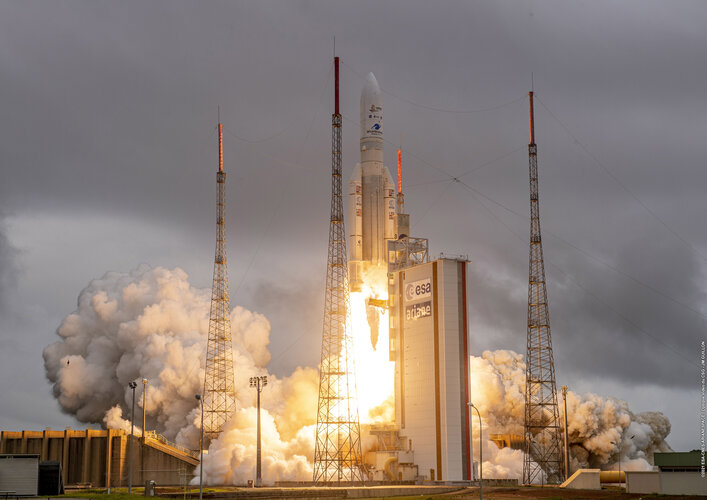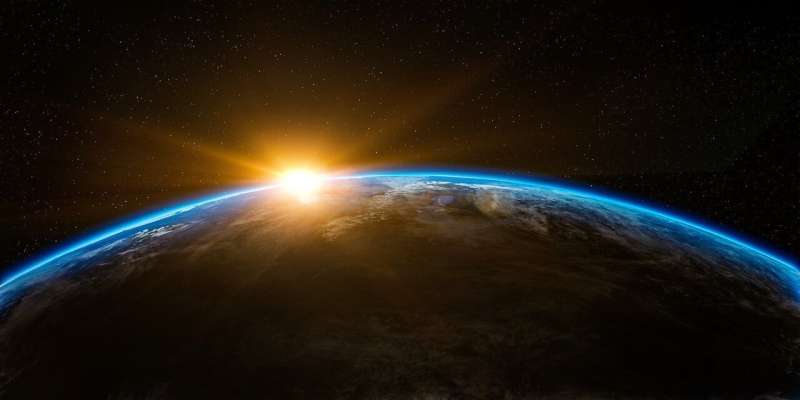
Copernical Team
First 2 O3b mPOWER satellites launched
 SES reports that the first two O3b mPOWER satellites were successfully launched into space by a SpaceX Falcon 9 rocket from Cape Canaveral Space Force Station in Florida, United States, at 5:48 pm local time.
Built by Boeing and designed to deliver unprecedented performance with first-of-its-kind software-driven payload, O3b mPOWER is SES's second-generation medium earth orbit (MEO) system
SES reports that the first two O3b mPOWER satellites were successfully launched into space by a SpaceX Falcon 9 rocket from Cape Canaveral Space Force Station in Florida, United States, at 5:48 pm local time.
Built by Boeing and designed to deliver unprecedented performance with first-of-its-kind software-driven payload, O3b mPOWER is SES's second-generation medium earth orbit (MEO) system JAXA startup Tenchijin announces funding from JAXA
 Tenchijin is pleased to announce the investment from the Japan Aerospace Exploration Agency ("JAXA"). This is the first ever investment of JAXA's capital investment into business.
This funding will enable Tenchijin to enhance its product capabilities and expand its usage to yield direct benefits for society and businesses on Earth. Since incorporation in 2019, Tenchijin has been developing
Tenchijin is pleased to announce the investment from the Japan Aerospace Exploration Agency ("JAXA"). This is the first ever investment of JAXA's capital investment into business.
This funding will enable Tenchijin to enhance its product capabilities and expand its usage to yield direct benefits for society and businesses on Earth. Since incorporation in 2019, Tenchijin has been developing AST SpaceMobile and NASA sign agreement to improve spaceflight safety
 AST SpaceMobile reports that its subsidiary, AST and Science, LLC, and NASA recently signed an agreement to formalize both organizations' dedication to maintaining and improving safety in the shared environment of space.
The Space Act Agreement formalizes the prompt, detailed, and open sharing of information between AST SpaceMobile and NASA, enabling a deeper level of coordination, coopera
AST SpaceMobile reports that its subsidiary, AST and Science, LLC, and NASA recently signed an agreement to formalize both organizations' dedication to maintaining and improving safety in the shared environment of space.
The Space Act Agreement formalizes the prompt, detailed, and open sharing of information between AST SpaceMobile and NASA, enabling a deeper level of coordination, coopera Third US-Republic of Korea Civil Space Dialogue
 Officials from the United States and the Republic of Korea (ROK) met in Seoul on December 15 and 16 for the third U.S.-Republic of Korea Civil Space Dialogue. Principal Deputy Assistant Secretary of the Bureau of Oceans and International Environmental and Scientific Affairs Jennifer R. Littlejohn led an interagency U.S. delegation.
The ROK delegation was jointly led by Kwon Hyun-joon, Dire
Officials from the United States and the Republic of Korea (ROK) met in Seoul on December 15 and 16 for the third U.S.-Republic of Korea Civil Space Dialogue. Principal Deputy Assistant Secretary of the Bureau of Oceans and International Environmental and Scientific Affairs Jennifer R. Littlejohn led an interagency U.S. delegation.
The ROK delegation was jointly led by Kwon Hyun-joon, Dire Space company Maxar plans to go private with $6.4 billion deal
 Space company Maxar announced an agreement to go private on Friday in an acquisition led by private equity firm Advent International.
The deal gives Maxar a value of $6.4 billion. Advent will take a $3.1 billion stake in the space company, with British Columbia Investment Management Corporation making a $1 billion equity contribution.
"This announcement is an exceptional outcome for
Space company Maxar announced an agreement to go private on Friday in an acquisition led by private equity firm Advent International.
The deal gives Maxar a value of $6.4 billion. Advent will take a $3.1 billion stake in the space company, with British Columbia Investment Management Corporation making a $1 billion equity contribution.
"This announcement is an exceptional outcome for One ESA: now in six languages

One ESA: now in six languages
The One ESA brochure explores ESA’s establishments and how they work together on European space missions. The brochure is printed in English and is available as a PDF and interactive format in five additional languages.
One year ago, a perfect launch for the James Webb Space Telescope

The voice counted backwards in French from ten to one, then announced, “Décollage” – lift-off. The 15-year-long collaboration between NASA, ESA and the Canadian Space Agency had just entered its most critical phase: the launch itself. What happened next would determine whether the James Webb Space Telescope made it into space or not.
SpaceX launches 54 Starlink communication satellites
 SpaceX launched a Falcon 9 rocket in Florida on Saturday carrying 54 Starlink Internet satellites.
The Falcon 9 was launched from Kennedy Space Center and was making its 15th flight to space. The rocket's first stage returned to Earth just under nine minutes later, landing on a SpaceX robotic drone ship stationed in the Atlantic Ocean off the Florida coast.
The satellites will ad
SpaceX launched a Falcon 9 rocket in Florida on Saturday carrying 54 Starlink Internet satellites.
The Falcon 9 was launched from Kennedy Space Center and was making its 15th flight to space. The rocket's first stage returned to Earth just under nine minutes later, landing on a SpaceX robotic drone ship stationed in the Atlantic Ocean off the Florida coast.
The satellites will ad Rocket Lab scrubs first U.S. Electron launch over high winds
 U.S. launch and space systems company Rocket Lab called off its Sunday evening liftoff of its first Electron rocket mission from the United States over upper-level high winds.
The launch at NASA's Wallops Flight Facility in Virginia was scrubbed with less than a dozen minutes left in the count down.
"All stations, unfortunately, we are going to be no go today," the launch directo
U.S. launch and space systems company Rocket Lab called off its Sunday evening liftoff of its first Electron rocket mission from the United States over upper-level high winds.
The launch at NASA's Wallops Flight Facility in Virginia was scrubbed with less than a dozen minutes left in the count down.
"All stations, unfortunately, we are going to be no go today," the launch directo Space crew using robotic arm to inspect damaged capsule

The crew of the International Space Station on Sunday was inspecting an attached Russian space capsule that may have been damaged by a micrometeorite, while ground controllers considered whether to send up a replacement spaceship to ferry some of them home.
Russia's space corporation, Roscosmos, said the crew was using a camera on a Canadian-built robotic arm to capture images of the Soyuz MS-22 where a coolant leak was detected last Wednesday night, U.S. time. After the images are transmitted to the ground on Monday, space officials will analyze them—along with other data about the problem—by month's end and decide on next steps.
One option, Roscomos said, is to expedite the delivery of another Soyuz capsule to the space station. Workers at the Baikonur Cosmodrome in Kazakhstan are preparing to launch Soyuz MS-23 to the space station next March with three crew members but could send it up sooner without a crew. That would allow some of the seven crew now on the space station to return home.
A Russian space official said last Thursday a micrometeorite could have caused the leak.

